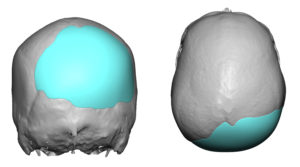Flattening of the back of the head is one of the most common aesthetic skull deformities. It can occur either as a total or bilateral flattening of the back of the head (occipital brachycephaly) or on just one side. (occipital plagiocephaly) The actual occurrences of either type of occipital skull deformity is not known and the only relevance of their occurrence is to that of the affected patient. In my clinical experience, asymmetry of the back of the head is the more common presentation seen for aesthetic treatment.
Plagiocephaly is a term that applies to an overall twisting of the skull shape around a vertical axis of rotation. This means that usually both the front and back of the skull are affected. The side that is flat on the back, the opposite front side will also have some degree of flattening as well. In most cases of plagiocephaly the occiput is more severely affected or flattened than that of the forehead.

Because the overlying scalp is often slightly thinner on the flatter side, it is usually best to overcorrect the flatter side by about 10% to compensate. This means increasing the central projection or thickest part of the implant to make up for any overlying soft tissue deficiency.
Dr. Barry Eppley
Indianapolis, Indiana


